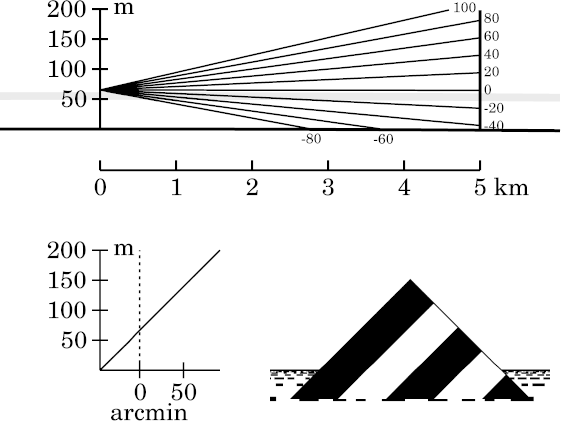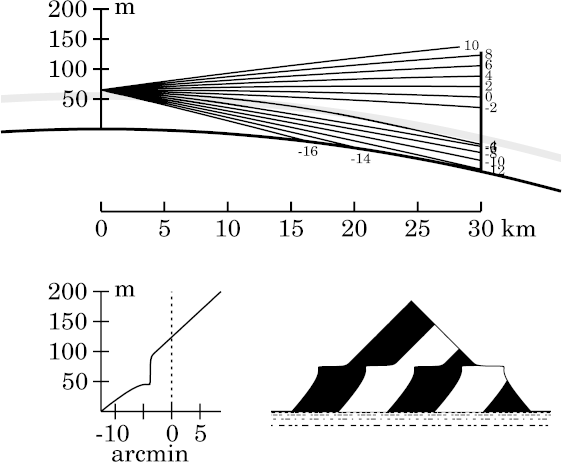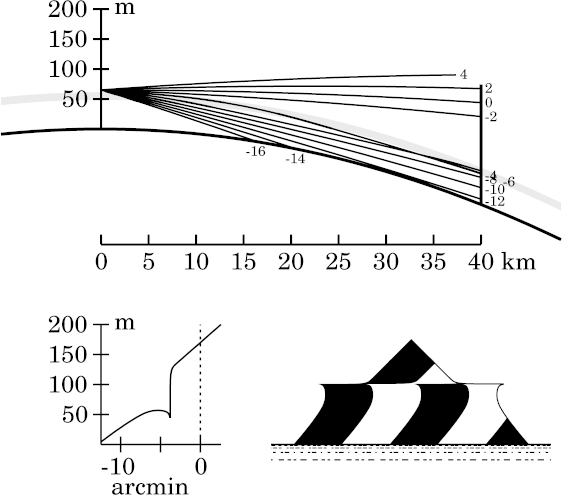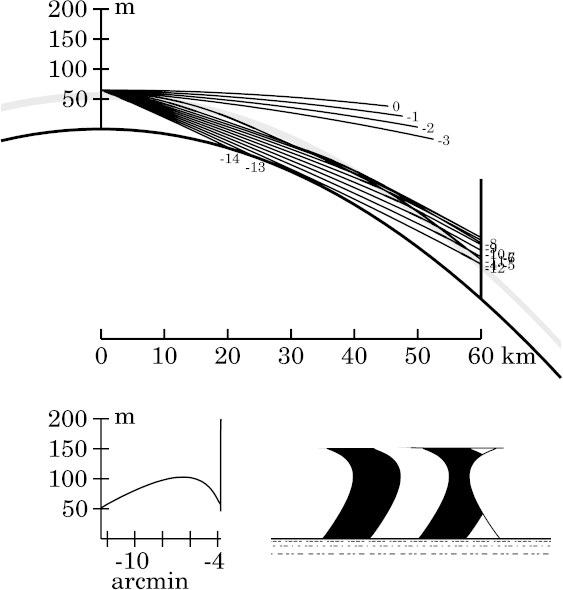As usual, I'll start with the target just a few kilometers away, to show that there's no perceptible distortion at short ranges.

You can see that the target is much closer than the apparent “sea
horizon”, both in the simulation at the right, and in the ray
diagram above it.
As usual, each ray is marked at its right-hand end with its
altitude (in minutes of arc) at the observer.

The upper part of the target, above the inversion, is seen through air with the standard lapse rate. So it's neither strongly displaced nor distorted.
However, the part of the target within the inversion layer is squashed together into a very thin interval of apparent altitude. That's the part between 50 and 60 m height, or the 5% of the 200 m-high target between 25% and 30% of its total height — see the little nearly-vertical piece of the transfer curve. So this zone of the target displays the effect called stooping (i.e., vertical compression).
This is an obvious consequence of the continuity of the image: the top is
hardly displaced, while the bottom is raised; so the part in between has
to be compressed.

First, note that the stooped zone (the vertical section of the transfer curve) is now much larger. This is the platform-like feature in the simulated image, produced by the much larger deflection of rays near the top of the duct. (Look at the big gap that has developed at the target between the rays the observer sees at altitudes of −2′ and −4′.)
But just below this, at about −5′, there's a zone where the sloping side of the target is imaged as a vertical line (the short horizontal feature in the transfer curve). If you look at the ray diagram, that's caused by the convergence of the rays at −4′ and −6′ at the target: a tiny piece of the target has been expanded to this 2′ interval in the image.

In the transfer curve, the flat spot near −5′ in the previous example has become a local maximum, so that features on the target near 50 m height are now seen at two different apparent altitudes: an erect image below, and inverted image above.
This appears to be a two-image mirage, with a discontinuity at the flat part of the image, between the inverted section seen at the top of the duct and the undistorted top above it. Actually, there is a third, erect image, so strongly compressed as to be effectively invisible, at this altitude, because of the vertical segment in the transfer plot. Whether or not there really is a discontinuity here depends on whether or not the lapse rate (rather than the temperature profile) is continuous.
The mock mirage here is not well developed; only about 1′ of the image is inverted. This might escape notice with the naked eye.

Here, at 60 km, the whole upper section of the target has been stooped down nearly into a line above the miraged part. The 2-image character of the mirage is now more evident.
Note that more than 2′ of the image is now inverted. This would certainly be visible to the naked eye.
Also, notice that the upper part of the inverted image is vertically compressed, compared to the erect portion below it (look at the slopes of the sides). Of course, the lower part is vertically stretched, where it joins the erect section — just as at the fold line in the inferior mirage.
Copyright © 2008 – 2009, 2012, 2013 Andrew T. Young
or the
introduction to all mirage simulations
or the
main mirage page
or the
GF home page
or the website overview page